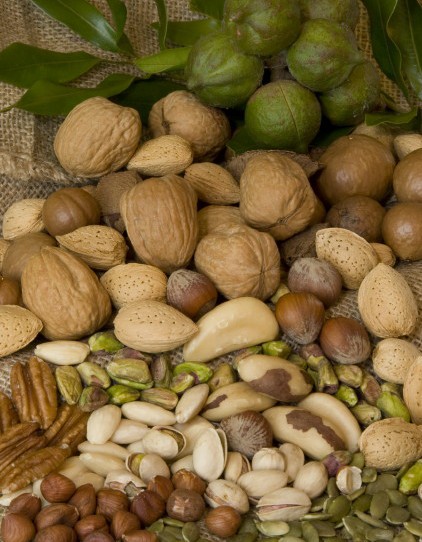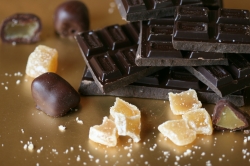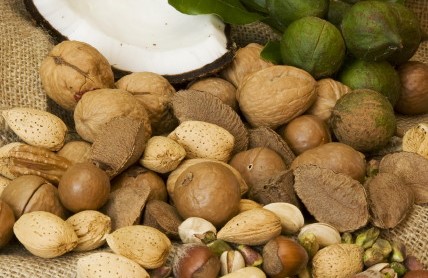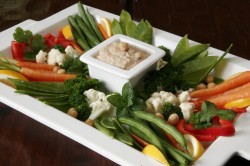An Apple A Day …
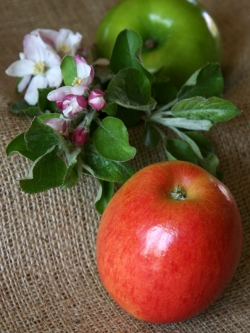
Historical Background
Botanical Plant Facts
Phytochemicals
Nutritional Facts
Shopping Tips
References
Who hasn’t heard the proverb “an apple a day keeps the doctor away?” What parents have passed on to their children for generations has been proven by science. In fact, this proverb is believed to have been cited as early as 1630. This portrayal of the manifold health benefits of apples will give you insight to why researchers are now going one step further and saying “an apple a day might keep the cancer at bay.”
In continuation of our series, “The Sweet Secrets of Fruit,” we will give you an overview of the manifold health benefits of apples (Malus ssp).
In 2005, each American on average bit into 16.92 pounds of fresh apples in addition to enjoying many other apple products such as apple juice, applesauce and dried apples. It comes as no surprise that the apple is such a popular fruit. Apples have something to offer for everyone’s taste, whether you like the very sweet Red Delicious, the slightly sour Fuji or the tart Granny Smith. Apples do not differ only in taste and texture; some are also richer in health-benefiting phytochemicals and nutrients than others. We hope that you will love every sweet, sour, firm or juicy bite of the apple of your choice even more and really include them in your diet.
Historical Background

The origin of apple trees is thought to be in Eastern Europe and Asia Minor. Evidence of cultivation dates back many thousand years. Egyptian pharaohs planted apple trees along the Nile during the mid 1200 B.C., and the ancient Greeks started cultivating apples around 700 B.C.
Hippocrates (around 400 B.C.), one of the first believers in nutritional healing(1), used apples as one of his preferred natural remedies for diseases. He recommended sweet apples as digestion aids and sour apples for fainting and constipation.
During the 1600’s, settlers brought apple seeds to America, and a few years later, in 1625, the first apple orchard near Boston was born. Today, around 4.5 million tons of apples are produced yearly in United States orchards.
Legend has it that Sir Isaac Newton’s (1642-1727) observation of falling apples led him to formulating the laws of gravity. Some publications even claim that he got the idea after an apple hit him on the head while he was sitting underneath an apple tree. While entertaining, this is most likely an exaggeration of Newton’s own tale about sitting by a window of his home (Woolsthorpe Manor) and watching an apple fall from a tree. However, it is now generally considered that even this story was invented by him in his later life.
Johnny Chapman (1774-1845), better known as Johnny Appleseed, is another popular character of apple history. He gained fame by spreading apple trees through the regions of what is now known as Ohio to Indiana over a period of 50 years. There is no other region in the United States where settlers planted more apple trees than he did. Even today, you will hardly find a farm in the region he covered without at least a few apple trees.
Due to a continuous popularity of apples over the centuries, many hybrids and cultivars have been developed, giving us thousands of different apples today. But only a few are commercially available.
Botanical Plant Facts
The apple is a tree fruit belonging to the plant family Pomoideae, which is a subfamily of the Rosaceae, or the rose family. Other members of thePomoideae family are quinces and pears. They are trees of temperate zones with cold winters. During the spring, you can see their trees blossoming with gorgeous white and pink flowers.
The apple is a classical false fruit. What does that mean? Apples ripen in the late summer and fall. Botanically, they are pome fruits with small, black and mildly poisonous seeds. The name is derived from the Pomoideae plant family. These fruits are made up of five or more carpels, which are the female reproductive units of the flowering plants. The edible, fleshy part of the fruit is the floral cup. A real fruit would develop out of the plant ovary. For this reason, biologists refer to apples as false fruits, also called accessory fruits.
Phytochemicals
Why it is well worth it to eat an apple a day? Studies reveal that apples, one of the best-researched fruits, are great in preventing many diseases. Apple intake(2,3) is especially associated with a reduced risk for the occurrence of all cancers combined, lung cancer, asthma, type 2 diabetes, cardiovascular diseases, thrombotic stroke, coronary and total mortality, symptoms of obstructive pulmonary diseases, as well as ischemic heart disease mortality.
One reason for the diverse, positive reactions in our body, is the phenolic content of apples. Phenols and polyphenols are secondary plant compounds with a wide range of active substances. Generally, they are antioxidants and may prevent degenerative diseases.
Apples are the number one source of phenols in the United States. A main phenolic compound found in apples is quercetin, a polyphenol, more precisely a flavonoid(4). This antioxidative and anticarcinogenic substance may stop human prostate and lung cancer cell growth and may lessen the incidence of cardiovascular diseases. Quercetin has proved to significantly protect neural cells from oxidative stress, which may prevent cognitive diseases such as Alzheimer’s(5). Besides that, it may be beneficial during cancer treatments, as it prevents nausea and vomiting(6).
Apples may support other aspects of cancer treatments as well. A recently published study(7) showed in detail on the molecular level the fantastic effects of an apple extract on breast cancer cells. The scientists were able to demonstrate that the phytochemicals in apples significantly inhibited a factor called NF-кB (nuclear factor kappa B) in human breast cancer cells. This factor is activated by stressors such as bacteria, viruses, inflammatory substances, growth factors, UV, oxidative stress and, unfortunately, cancer treatment drugs. The consequences of an abnormal NF-кB activation are severe. This factor is involved in regulating cell growth. Cancer treatment drugs become actually ineffective as they turn on NF-кB as a side effect and therefore promote cell growth instead of stopping it. The solution would be to give even stronger medication or to find a way to stop NF-кB from coming into effect. Here, the apple compounds come into play. The phytochemicals in apples are able to stop this factor from being activated and therefore may be an amazing support during cancer treatments.
Not only that, anticancerous effects of whole apple extracts(7) have been discovered at other sites of the body. Chemopreventive actions appeared when testing effects on colon cancer and liver cancer cell growth.
Cold and influenza season is approaching. Studies have shown that apples, along with other fruits (quinces and Chinese quinces), are significantly effective in inactivating influenza viruses(8).
For all expecting mothers: a study with over 2,000 participating mothers and children revealed eating apples during pregnancy might protect your children from developing childhood asthma(9). But, why apples are associated with a lower risk for asthma is not clear at this point. It could be due to the effects of specific compounds in the apple. Or it may be simply lifestyle related. The participating mothers may have been living healthier with an overall higher intake of fruits. More research is necessary at this point.
A significant amount of apples’ effects seem to come from the peel. Apple peels have a higher antioxidant and antiproliferative activity than the flesh. Partly responsible for the effects of apple peels is a phytochemical group called triterpenoids(10). These bioactive substances are able to stop the growth of human liver cancer, human colon cancer and human breast cancer cells. The exact mechanisms of how the triterpenoids work need more clarification and research, but it already seems to be very promising. Also, other active compounds responsible for the anticancerous fighting activities have yet to be identified. Regardless, if you find good-quality, preferably organic apples, don’t peel them.
The frequent intake of apple juice(11) may lower the oxidation of the bad LDL-cholesterol. This effect derives from the apple flavonoid content as well, and may result in a lowered risk for atherosclerosis. Additionally, cloudy apple juice has been shown to reduce DNA damage and hyperproliferation in animal colon cells(12). Another study showed that drinking apple juice may help your memory. It accomplishes this by stopping the important neurotransmitter acetylcholine from declining(13) in the brain. Cloudy, unclarified apple juice is much more healthful than clear apple juice; it has up to four times more polyphenols. Unsweetend and cloudy apple juice should always be your first choice if you or your children feel like drinking a glass.
Apple vinegar can also be consumed(14). The so-called “Vermont drink” is a beverage made from apple vinegar and honey. It has been reported that the people of Vermont enjoy healthy longevity because of this drink. Scientists were able to prove that apple vinegar may reduce hypertension and may be anti-tumor active.
As mentioned earlier, not every apple is the same. The phenol concentration can range from 110 to 357 mg/100 g fresh apple(15). But what are the “healthiest” apples with the highest antioxidant activities?
In 2005, a Canadian study(4) analyzed the antioxidant activity of eight apple cultivars with the help of the FRAP-Test (ferric-reducing ability of plasma). They studied apple peel and flesh samples of Empire, Mustu, McIntosh, Golden Delicious, Cortland, Ida Red, Northern Spy and Red Delicious. The following table gives you an overview of measured antioxidant values in apple peels and fleshes.
Total antioxidant activity of apple peels and fleshes (in micromolar, adapted from Tsao et al(4)).
| Apple cultivar | Peel | Flesh |
| Red Delicious | 17851 | 3215 |
| Northern Spy | 10044 | 6425 |
| Ida Red | 12083 | 2749 |
| Cortland | 11908 | 3660 |
| Golden Delicious | 9616 | 2036 |
| McIntosh | 6436 | 2785 |
| Mutsu | 6820 | 1584 |
| Empire | 2736 | 550 |
Red Delicious, Northern Spy, Ida Red and Cortland are the apples with the highest antioxidant concentrations. The lowest concentrations were found in Empire apples. Interestingly, the Red Delicious apple is not only ranked high in this study, but it is also the most commonly apple grown in the United States.
As mentioned earlier, apple peels are especially rich in antioxidants. However, the highest intake of these components stems from the apple flesh, because apples contain so much more flesh than skin.
Overall, it seems like an apple a day does actually keep the doctor away – or should we say the general practitioner, oncologist, internal specialist, diabetologist, cardiologist, pediatrician, neurologist…
Nutritional Facts
Additional health benefits of apples are derived from their vitamin C and K, potassium and dietary fiber content, as you can see in the nutritional facts table below(16). The values given are for a single medium-sized fruit:
| Nutritional Values | Apple |
| Calories | 72 kcal |
| Carbohydrates | 19 g |
| Dietary Fiber | 3 g |
| Protein | 0 g |
| Fat | 0 g |
| Water | 118 g |
| Vitamins | C, K & B 6 Minor concentrations of A, E, B 1, B 2, Niacin, Folate & Pantothenic Acid |
| Minerals | Potassium Minor concentrations of Magnesium, Phosphorus, Copper & Manganese |
Vitamin C in particular adds to the antioxidant activity of phenols found in apples(3).
In general, a multiplicity of compounds is responsible for the apple’s great benefits(17). Therefore, eat the whole fruit without the core.
It is so easy to include an apple in your diet, as it fits in every pocket or business bag. For more suggestions, check out our breakfast article “Make the Best Start to Your Day.”
Shopping Tips
Apples are available all year. Keep them in a cool, dark place. Storing them in a refrigerator will ensure freshness for up to one month. As always, choose local produce and organic when possible, to support local businesses and to save natural resources needed for long transportation routes.
Whatever you do, do not store apples with other fruits. They emit a gas called ethylene, which is a ripening gas. The food industry uses this chemical to ripen fruits such as bananas that have been harvested green to the perfect ripeness before they are sold in stores. However, what the food industry uses to its advantage is a disadvantage in your kitchen. Apples cause produce items stored close to them to ripen faster and, ultimately, spoil faster. Also, before storing apples, sort out any spoiled ones, as they might spoil the rest. This is where another proverb, “one bad apple spoils the whole barrel,” comes from. Keeping apples at cool temperatures will slow down the ethylene release, and they will last longer.
Look for firm, crisp apples without any bruises. Also, chose well-colored ones without any browning. Sometimes the shiny surface comes from sprayed-on waxes, which need to be washed off. Apples are ranked second on the list of most-pesticide-treated produce items. Therefore, make sure you buy either organic produce or wash the apples well before eating. For more information on pesticides and how to clean produce right, see the article “It’s Stone-Fruit Season – Time To Get Peachy.”
Soft spots often found on apples mostly originate from the customers themselves. They are nothing more than fingerprints from squeezing the fruit too hard. Only gentle pressure is necessary to determine the firmness of an apple!
As noted before, if you want to drink apple juice, go for organic cloudy unsweetened apple juice. Our suggestion: if you own a juicer, make some yourself. If you know a water provider in your area that offers excellent quality water, preferably in glass bottles, we recommend diluting cloudy apple juice 1 to 1 with sparkling water. It makes a great refreshing drink. This is a wonderful and very tasty, healthful alternative to sodas. The kids will love it.
Last but not least, a fun fact: Have you ever noticed that apples float in the water, and wondered how this works, since they are fairly heavy? They contain 25% air. This is enough to make them float.
(1) Kim Es and Hong WK: An Apple a Day … Does It Really Keep the Doctor Away? The Current State of Cancer Chemoprevention. Journal of the National Cancer Institute 2005;97(7)468-470.
(2) Knekt P, Kumpulainen J, Järvinen R, Rissanen H, Heliövaara M, Reunane A, Hakulinen T and Aromaa W: Flavonoid intake and risk of chronic diseases.American Journal of Clinical Nutrition 2000;76:560-568.
(3) Vanzani P, Rossetto M, Rigo A, Vrhovsek U, Mattivi F, D’Amato E and Scarpa M: Major Phytochemicals in Apple Cultivars: Contribution to Peroxyl Radical Trapping Efficiency. Journal of Agricultural and Food Chemistry 2005;53:3377-3387.
(4) Tsao R, Yang R, Xie S, Sockovie E and Khanizadeh S: Which Polyphenolic Compounds Contribute to the Total Antioxidant Activities of Apple? Journal of Agricultural and Food Chemistry 2005;53:4989-4995.
(5) Heo HJ and Lee CY: Protective Effects of Quercetin and Vitamin C against Oxidative Stress-Induced Neurodegeneration. Journal of Agricultural and Food Chemistry 2004;52(25)7514-7517.
(6) Lee BH, Jung SM, Lee JH, Kim JH, Yoon IS, Lee JH, Choi SH, Lee SM, Chang CG, Kim HC, Han Y, Paik HD, Kim Y and Nah SY: Quercetin Inhibits the 5-Hydroxytryptamine Type 3 Receptor-mediated Ion Current by Interaction with Pre-Transmembrane Domain I. Molecules and Cells 2005;20(1)69-73.
(7) Yoon H and Liu RH: Effect of Selected Phytochemicals and Apple Extracts on NF-кB Activation in Human Breast Cancer MCF-7 Cells. Journal of Agricultural and Food Chemistry 2007;55:3167-3173.
(8) Hamauzu Y, Yasui H, Inno T, Kume C and Omanyuda M: Phenolic Profile, Antioxidant Property, and Anti-influenza Viral Activity of Chinese Quince (Pseudocydonia sinensis Schneid.), Quince (Cydonia oblonga Mill.) and Apple (Malus domestica Mill.) Fruits. Journal of Agricultural and Food Chemistry 2005;53:928-934.
(9) Willers SM, Devereux G, Craig LCA, McNeill G, Wijga AH, Abou El-Magd W, Turner SW, Helms PJ and Seaton A: Maternal food consumption during pregnancy and asthma, respiratory and atopic symptoms in 5-year-old children. Thorax 2007;62:772-778.
(10) He X and Liu RH: Triterpenoids isolated from Apple Peels Have Potent Antiproliferative Activity and May Be Partially Responsible for Apple’s Anticancer Activity. Journal of Agricultural and Food Chemistry 2007;55:4366-4370.
(11) Davis PA, Polagruto JA, Valacchi G, Phung A, Soucek K, Keen CL and Gershwin ME: Effect of Apple Extracts onNF-кB Activation in Human Umbilical Vein Endothelial Cells. Experimental Biology and Medicine 2006;231:594-598.
(12) Pohl C, Will F, Dietrich H and Schrenk D: Cytochrome P450 1A1 Expression and Activity in Caco-2 Cells: Modulation by Apple Juice Extract and Certain Apple Polyphenols. Journal of Agricultural and Food Chemistry 2006;54:10262-10268.
(13) Chan A, Graves V and Shea TB: Apple juice concentrate maintains acetylcholine levels following dietary compromise. Journal of Alzheimer’sDisease 2006 ;9(3) 287-291.
(14) Abe K, Kushibiki T, Matsue H, Furukawa KI and Motomura S: Generation of Antitumor Active Neutral Medium-Sized α-Glycan in Apple Vinegar Fermentation. Bioscience, Biotechnology and Biochemistry 2007;71:60670-1-6.
(15) Veeriah A, Hofmann T, Glei M, Dietrich H, Will F, Schreier P, Knaup B and Pool-Zobel BL: Apple Polyphenols and Products Formed in the Gut Differently Inhibit Survival of Human Cell Lines Derived from Colon Adenoma (LT97) and Carcinoma (HT29). Journal of Agricultural and Food Chemistry 2007;55:2892-2900.
(16) NutritionData – Nutrition Facts and Calorie Counter: Apples. www.nutritiondata.com, retrieved September 2007.
(17) Liu RH, Liu J and Chen B: Apples prevent mammary tumors in rats.Journal of Agricultural and Food Chemistry 2005;53:2341-2343.
- Posted October 23, 2007
© 2007-2025 Janett Walter and Take The Magic Step®
